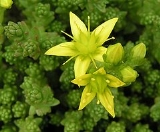
Sedum
Overview
Genus
In biology, a genus is a low-level taxonomic rank used in the biological classification of living and fossil organisms, which is an example of definition by genus and differentia...
of flowering plant
Flowering plant
The flowering plants , also known as Angiospermae or Magnoliophyta, are the most diverse group of land plants. Angiosperms are seed-producing plants like the gymnosperms and can be distinguished from the gymnosperms by a series of synapomorphies...
s in the family Crassulaceae
Crassulaceae
Crassulaceae, or the orpine family, are a family of dicotyledons. They store water in their succulent leaves. They are found worldwide, but mostly occur in the Northern Hemisphere and southern Africa, typically in dry and/or cold areas where water may be scarce...
, members of which are commonly known as stonecrops. It contains around 400 species of leaf succulents that are found throughout the Northern Hemisphere
Northern Hemisphere
The Northern Hemisphere is the half of a planet that is north of its equator—the word hemisphere literally means “half sphere”. It is also that half of the celestial sphere north of the celestial equator...
, varying from annual
Annual plant
An annual plant is a plant that usually germinates, flowers, and dies in a year or season. True annuals will only live longer than a year if they are prevented from setting seed...
and creeping herbs
Herbaceous plant
A herbaceous plant is a plant that has leaves and stems that die down at the end of the growing season to the soil level. They have no persistent woody stem above ground...
to shrub
Shrub
A shrub or bush is distinguished from a tree by its multiple stems and shorter height, usually under 5–6 m tall. A large number of plants may become either shrubs or trees, depending on the growing conditions they experience...
s. The plants have water-storing leaves. The flowers usually have five petals, seldom four or six. There are typically twice as many stamen
Stamen
The stamen is the pollen producing reproductive organ of a flower...
s as petals.
A number of species, formerly classified as Sedum, are now a separate genus Hylotelephium
Hylotelephium
Hylotelephium is a genus of family Crassulaceae. It includes about 33 species distributed in Asia, Europe, and North America.Species in the genus, formerly included in Sedum, are popular garden plants, known as "live-for-ever" or "orpine."...
.
Well known European Sedums are Sedum acre
Sedum acre
Sedum acre, commonly known as the Goldmoss Stonecrop, Goldmoss Sedum, Biting Stonecrop, Wallpepper, and the picturesque name Welcome home husband though never so drunk, is a perennial plant native to Europe, but also naturalised in North America. This plant grows as a creeping ground cover, often...
, Sedum album
Sedum album
Sedum album or White stonecrop, is a flowering plant of the genus Sedum in the family Crassulaceae. Sedum album is able to acclimate according to the environment...
, Sedum dasyphyllum, Sedum reflexum
Sedum reflexum
Sedum reflexum or Sedum rupestre, also known as Reflexed Stonecrop, Blue Stonecrop, Jenny's Stonecrop and Prick-madam, is a species of succulent plant of the genus Sedum, native to Northern, Central, and Southwestern Europe.-Description:The Sedum reflexum plants are typically up to 10 cm high, with...
(also known as Sedum rupestre) and Sedum hispanicum.
Many sedums are cultivated
Horticulture
Horticulture is the industry and science of plant cultivation including the process of preparing soil for the planting of seeds, tubers, or cuttings. Horticulturists work and conduct research in the disciplines of plant propagation and cultivation, crop production, plant breeding and genetic...
as garden
Garden
A garden is a planned space, usually outdoors, set aside for the display, cultivation, and enjoyment of plants and other forms of nature. The garden can incorporate both natural and man-made materials. The most common form today is known as a residential garden, but the term garden has...
plants, due to their interesting and attractive appearance and hardiness.
Unanswered Questions

